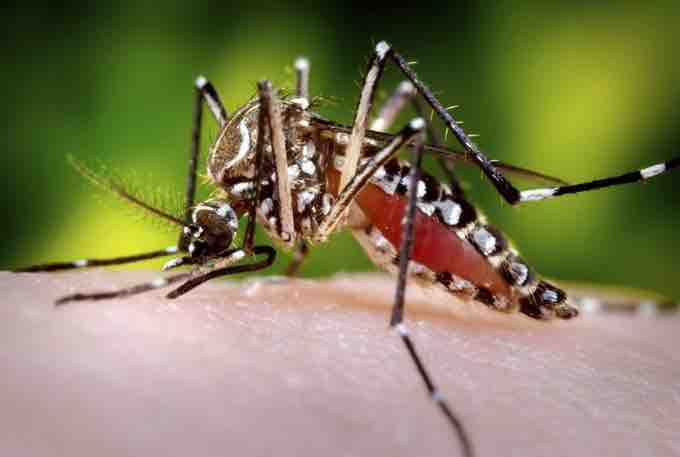Chikungunya Virus (CHIKV)
Chikungunya (in the Makonde language "that which bends up") virus (CHIKV) is an insect-borne virus of the genus Alphavirus, that is transmitted to humans by virus-carrying Aedes(Ae) mosquitoes. Both Ae. aegypti and Ae. albopictus have been implicated in large outbreaks of CHIKV.
CHIKV infection causes an illness with symptoms similar to dengue fever, with an acute febrile phase of the illness lasting only two to five days, followed by a prolonged arthralgic disease that affects the joints of the extremities. The pain associated with CHIKV infection of the joints persists for weeks or months or, in some cases, years. CHIKV is indigenous to tropical Africa and Asia, where it is transmitted to humans by the bite of infected mosquitoes .

Close up of Aedes aegypti mosquito
The Aedes aegypti mosquito is the principle vector responsible for transmitting the chikungunya virus to humans.
SIGNS AND SYMPTOMS
The incubation period of chikungunya disease ranges from one to 12 days, but usually two to three. Its symptoms include a high fever up to 40 °C (104 °F), a petechial or maculopapular rash of the trunk and occasionally the limbs, and arthralgia or arthritis affecting multiple joints. Other nonspecific symptoms can include headache, conjunctivitis, slight photophobia and partial loss of taste. Typically, the fever lasts for two days and then ends abruptly. However, other symptoms—namely joint pain, intense headache, insomnia and an extreme degree of prostration—last for a variable period; usually for about five to seven days. Patients have complained of joint pains for much longer time periods; some for as long as two years, depending on their age.
DIAGNOSIS
Common laboratory tests for chikungunya include RT-PCR, virus isolation, and serological tests.
Virus isolation provides the most definitive diagnosis, but takes one to two weeks for completion and must be carried out in biosafety level-3 laboratories. The technique involves exposing specific cell lines to samples from whole blood and identifying chikungunya virus-specific responses. RT-PCR using nested-primer pairs is used to amplify several chikungunya-specific genes from whole blood. Results can be determined in one to two days. Serological diagnosis requires a larger amount of blood than the other methods, and uses an ELISA assay to measure chikungunya-specific IgM levels. Results require two to three days.
TREATMENT
There are no specific drugs to cure the disease. Treatment is directed primarily at relieving the symptoms, especially the joint pain. There is no commercial chikungunya vaccine.
CHIKUNGUNYA OUTBREAKS
Chikungunya occurs in Africa, Asia, and the Indian subcontinent. Human infections in Africa have been at relatively low levels for a number of years, but in 1999-2000 there was a large outbreak in the Democratic Republic of the Congo, and in 2007 there was an outbreak in Gabon. Starting in February 2005, a major outbreak occurred in islands of the Indian Ocean. A large number of imported cases in Europe were associated with this outbreak, mostly in 2006 when this epidemic was at its peak.
A large outbreak of chikungunya in India occurred in 2006 and 2007. Several other countries in South-East Asia were also affected. In 2007 transmission was reported for the first time in Europe, in a localized outbreak in north-eastern Italy.